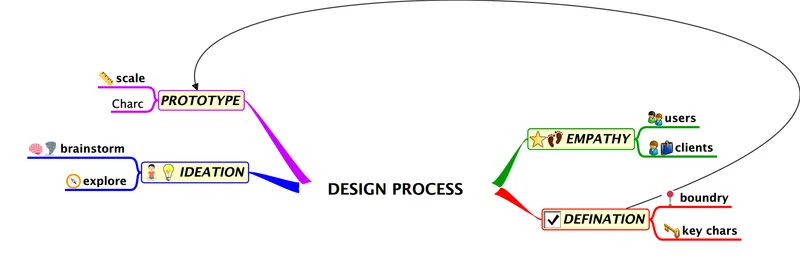

Mind Mapping in User Experience
Human brains process images 60,000 times faster than it processes text information. The human brain is wired to communicate better in a visual way. Images have always impacted our long-term memories.
Human brains process images 60,000 times faster than it processes text information. The human brain is wired to communicate better in a visual way. Images have always impacted our long-term memories. Consider an old photo triggering a milieu of emotions and at the same time, an attractive window-shopping display or online shopping window stays put on your memory.
An extension to the imagery learning is seen in the educational system. Images and videos are creating an engaging learning platform, explaining concepts that remain etched in memory. Talking about learning, the concept of mind maps comes to simplify things by learning through pictorial & graphical representations. The concept of Mind maps was first introduced by Tony Buzan (www.TonyBuzan.com) who was a British Psychologist, Educational Consultant and an Author.
Mind Maps are pictorial or graphical representations that are often very colourful and come to represent educational projects, complex processes, and a tool for brainstorming. Mind maps come to simplify, analyze, organize and represent processes in a systematic and graphical form.
Mind Maps are the colourful, imaginative, articulate, multi-dimensional, streamlined flow of ideas that come to form a 2D prototype of the issue at hand.

Mindmap process
Mind Maps are very powerful visual mapping strategies for creating detail-oriented and well-articulated process designs. While students use them to memorize concepts, take notes, analyze or prepare presentations, we have seen the use of mind maps in driving complex design work.
User Experience being a design-oriented process, makes the use of design, scribbles, graphics or pictorial representations to brainstorm or present projects. While flow chart is the age-old tool software professionals have grown up with, it has its own restrictions, Concept mapping another tool is used in exhaustive processes and very vast. A concept mapping process can involve mind maps as a category within. Concept maps come with different parent categories whereas mind maps have a single parent category. Another tool designers have been using is Ontology map, which is branched and specifically connects back and forth and also serves as a connection between two entities. Different tools come to emphasise their individual skills, but mind maps are easy, communicative and attractive to stay focused and act.
Smashing magazine states in an article on Design Thinking Process that it involves five stages: empathy, definition, ideation, prototyping, and testing. Designers can easily use mind maps as hierarchical structures to create a clear picture around these five stages.
Why Mind Maps in Design?
Mind Maps make researching easier
Every topic of discussion becomes the parent topic, that bifurcates into different branches of information that comes to define the parent topic. These branches of information can be classified as a source of information, analysis method, data compilation, statistics representation methods, presentation methods, results and conclusions, demographics and sources to publish. Mind maps offer a wide spread of activities in one vision, emphasising on every aspect that calls for information.

Mindmap in UX design process
Grouping and Sub-grouping
Designers can bifurcate every aspect of the design process into groups and sub-groups. Considering empathy as a parent topic means primarily identifying customer age groups, then branch further to lifestyle, brand preferences, buying patterns, current trends, offers etc.
Buying patterns could also be bifurcated further to spending capacity, discounted sale preferences, repetitive site visits and delayed buying, impulsive buying behaviour, random shopping patterns and all these and many more parameters.
Action-based Commands
Mind maps are not only visual representations of projects but backed by action-based commands to effect action. A good mind map not only lists ideas and end results but the process that can be taken to effect results. Mind maps are therefore action-based and not just pictorial representations.
An app development process would incorporate:
Market Survey
- Run a detailed survey of local as well as national markets to check your App's novelty.
- App users and age groups, phone types- Android or iPhone users.
- Current users of a similar existing App etc.
Prototype
- Authentic design and usability.
- Adaptations – windows, android and iPhone.
- Design scalability.
Such action-based commands can be used in mind maps for clarity of instructions.
Colourful and easy representations
Mind maps are meant to be colourful and attractive to impact results unlike cognitive maps, concept maps or flow charts that basically represent process flows. Mind maps are interactive and engaging wireframes that bring the diverse possibilities of an aspect for wider study and results.

Usage of Mind Map
The cognitive brain understands and responds better to design and pictorial elements to process and remember.
Colourful Artistic Designs Boards to Actual UI designs:
Mind maps can be an easy colourful and unusual way to offer client presentations. A UX designer can bring in a detailed map of a User Interfaces that will mark the different pages, page attributes, payment systems, forms, colour themes, templates, back-end/front-end software etc. Imagine such an unusually detailed and attractive presentation will certainly have the client curious for what's in store.
Mind Map as a Brainstorming Tool:
The concept of a mind map is a brush that can paint a blank canvas in varied shades. A central and parent topic identified mind maps give you a liberty of thinking in every aspect and direction unlike flow-charts that are dominated with monosyllabic - Yes or No responses.
Mind maps can capture the if's and buts, why and how of an idea and progress it by action-packed process flow.
Adaptations of Mind Maps:
Mind maps can be used within the exhaustive Concept Maps to represent Subject-matter or a primary category and its subcategories thereof. Imagine an e-commerce website that is a mesh of interlinked processes and pages. In such designs, mind maps can be incorporated under Concept Maps to associate different parent categories and possible connections.

Usage of Mind map
Mind Map Apps:
Although, mind maps bring a sensory pleasure if you are physically preparing them, drawing every object, picking a different colour to identify, differentiate and simplify processes. However, not everyone can bring out creativity and not everyone has the leisure for artistic inclinations. There are some Apps that offer simple to complex mind map templates that you can just feed with inputs.
- MindMaster (https://www.edrawsoft.com/mindmaster/)
- Lucidchart (https://www.lucidchart.com/pages/examples/mind_mapping_software)
are two of the best Mind Mapping Apps in 2020 that are compatible with windows, iOS, android and Linux platforms.
Mind maps are organized representations that amplify your ideas and project them in a streamlined process format. If nothing else, mind maps are a visual treat to simplicity that could captivate any designer to start using them.
All the images used in this article were created by eminent mind map experts Mr. Pushkaraj Kolatkar of LearnMindmap.







